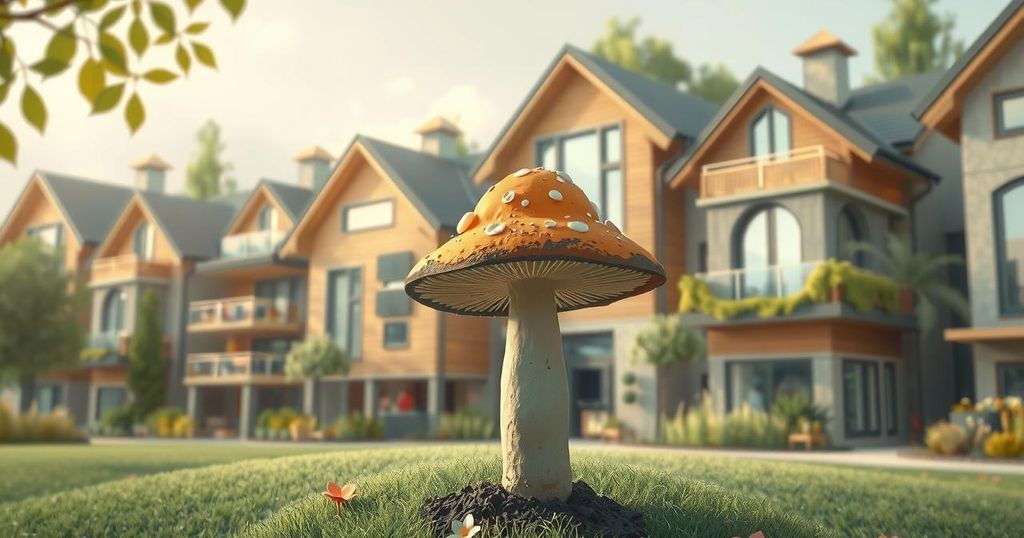Namibia confronts a housing crisis with over 40% of its population in informal settlements, exacerbated by costly conventional construction methods. Innovative research into mushroom waste and invasive plants offers a sustainable, cost-effective solution for building materials. Pilot projects have shown success in insulation and carbon footprint reduction, but challenges remain in scaling production and market adoption. Collaborations are essential for future development, representing a potential game-changer for affordable housing.
Namibia is facing a significant housing crisis, with over 40% of its population living in informal settlements, including 70% of urban residents. The capital, Windhoek, is particularly affected by a lack of affordable housing, despite a demand for over 300,000 new homes. Conventional construction methods exacerbate the situation due to high costs and environmental degradation, as they rely on costly materials like cement, steel, and timber, complicating the creation of affordable housing.
Invasive encroacher bushes have overtaken 45 million hectares of Namibian land, affecting agriculture and groundwater amid dwindling water supplies. To combat this, the government has initiated a plan to burn 300 million tonnes of this invasive bush every 15 years for charcoal production while attempting to mitigate its negative environmental impacts, especially concerning carbon emissions linked to land use and forestry.
In response to the housing and ecological challenges, innovative local researchers have partnered with institutions like MIT and Standard Bank to utilize organic waste and invasive species for building materials since 2019. They developed mycoblocks from mushroom waste and invasive plants, thus creating cost-effective and durable alternatives for housing while addressing waste management issues.
The production process involves harvesting and chipping the invasive bush, mixing it with nutrients and water, and inoculating it with fungal mycelium at a specialized facility. The resultant mixture is cultivated into bricks, ready for use in construction. Notably, early pilot projects show these blocks provide better insulation, offering energy savings for homeowners.
The project has produced substantial benefits, including the first self-supporting mycelium structure in Brakwater. By converting over 12 tons of bush into three tons of marketable mushrooms and producing approximately 1,000 mycoblocks, this initiative also sequestered around 12 tons of carbon dioxide, demonstrating significant environmental benefits.
Furthermore, the use of these innovative materials aids in restoring ecosystems by controlling invasive species and utilizing agricultural by-products efficiently. This circular economy model is essential for reducing landfill waste and promoting sustainability in Namibian communities.
Despite its promise, the initiative grapples with scaling production to meet housing demand. Initial costs for production facilities hinder small-scale operations, while market adoption of these new building materials requires more awareness and education among local builders and communities to facilitate broader acceptance and understanding.
Future collaborations with government and private sector partners are essential for expanding the project. The focus on exploring various applications of mushrooms in construction may lead to significant advances in sustainable architecture, benefiting rural areas and addressing housing shortages in Namibia.
The global interest in fungi for construction continues to grow due to its sustainability potential compared to traditional materials. As researchers advance methods for larger-scale production of fungi-based building materials, this technology could redefine affordable housing solutions and positively impact climate change by lowering the construction sector’s carbon footprint.
In conclusion, the use of mushrooms in building processes embodies a sustainable innovation that addresses Namibia’s housing crisis while combating climate change. By leveraging local organic materials and invasive species, this initiative offers a scalable model for environmentally conscious construction, presenting a viable path forward for sustainable living and resource management in Namibia and beyond.
In summary, Namibia’s innovative approach of using mushroom waste and invasive plants aims to tackle its housing crisis while promoting sustainability. This initiative not only offers a viable solution to the pressing need for affordable housing but also supports carbon sequestration efforts and ecosystem restoration. As production scales, it holds potential implications for the wider African region and the global housing sector, advocating for greener building practices.
Original Source: www.fairplanet.org






